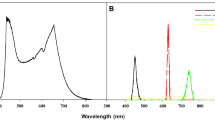Abstract
The period length of the leaf movement rhythm of Trifolium repens L. is lengthened by continuously offered cAMP (0.5–1.0 mol m-3) and theophylline (0.5–4 mol m-3). At the higher concentrations this effect is more pronounced and the rhythm damps out faster. Imidazole (0.5 and 1 mol m-3) has no effect on the period length; however, after 5 mol m-3 the rhythm is abolished. Offered as 4 h pulses the resulting phase response curves for cAMP and imidazole are similar and show delays of up to 4 h during the day position of the leaves. Theophylline pulses lead to delays of up to 5 h during closure and advances of up to 3 h during opening. No phase shift is brought about by 4-(3,4-dimethoxybenzyl)-2-imidazolidone. The results do not support the cAMP-model of the circadian clock which has been proposed by Cummings (J. theor. Biol. 55, 455–470; 1975). The effect of the substances tested could, however, be based upon influences on the transport of Ca2+.
Similar content being viewed by others
Abbreviations
- ATP:
-
adenosine triphosphate
- cAMP:
-
cyclic adenosine 3′5′ monophosphate
- AMP:
-
adenosine 5′ monophosphate
- AC:
-
adenyl cyclase
- PDE:
-
phosphodiesterase
- LL:
-
continuous light
References
Amrhein, N.: The current status of cyclic AMP in higher plants. Ann. Rev. Plant Physiol. 28, 123–132 (1977)
Benson, I.A., Jacklet, J.W.: Circadian rhythm of output from neurones in the eye of Aplysia. IV. A model of the clock; differential sensitivity to light and low temperature pulses. J. exp. Biol. 70, 195–211 (1977)
Bopp, M.: Die Bedeutung von cAMP für die pflanzliche Entwicklung. Fortsch. Bot. 37, 168–170 (1975)
Brown, E.G., Al-Najafi, T., Newton, R.P.: Cyclic nucleotide phosphodiesterase activity in Phaseolus vulgaris. Phytochemistry 16, 1333–1337 (1977)
Bünning, E.: Die physiologische Uhr. 2. Auflage, Springer, Berlin (1963)
Bünning, E.: Die physiologische Uhr. 3. Auflage, Springer Verlag, Berlin (1977)
Chapman, R.A., Miller, D.J.: Structure-activity relations for caffeine: a comparative study of the inotropic effects of the methylxanthines, imidazoles, and related compounds on the frog's heart. J. Physiol. 242, 615–634 (1974)
Cummings, F.W.: A biochemical model for the circadian clock. J. theor. Biol. 55, 455–470 (1975)
Ehret, C.F., Potter, V.R., Dobra, K.W.: Chronotypic action of theophylline and of pentobarbital as circadian Zeitgebers in the rat. Science 188, 1212–1215 (1975)
Engelmann, W.: A slowing down of circadian rhythms by lithium ions. Z. Naturforsch. 28c, 733–736 (1973)
Eskin, A., Corrent, G.: Effects of divalent cations and metabolic poisons on the circadian rhythm from the Aplysia eye. J. comp. Physiol. 117, 1–21 (1977)
Feldman, J.F.: Lengthening the period of a biological clock in Euglena by cycloheximide, an inhibitor of protein synthesis. Proc. Natl. Acad. Sci. USA 57, 1080–1087 (1967)
Feldman, J.F.: Circadian periodicity in Neurospora: alteration by inhibitors of cyclic AMP phosphodiesterase. Science 190, 789–790 (1975)
Johnson, P.N., Inesi, G.: The effect of methylxanthines and local anaesthetics on fragmented sarcoplasmatic reticulum. J. Pharmacol. Exp. Ther. 169, 308–314 (1969)
Johnsson, A., Karlsson, H.G.: A feedback model for biological rhythms. I. Mathematical description and basic properties of the model. J. theor. Biol. 36, 153–174 (1972)
Karakashian, M.W., Schweiger, H.G.: Temperature dependence of cycloheximide-sensitive phase of circadian cycle in Acetabularia mediterranea. Proc. Natl. Acad. Sci. USA 73, 3216–3219 (1977)
Keller, S.: Über die Wirkung chemischer Faktoren auf die tagesperiodischen Blattbewegungen von Phaseolus multiflorus. Z. Bot. 48, 32–57 (1960)
Mayer, W., Gruner, R., Strubel, H.: Periodenverlängerung und Phasenverschiebungen der circadianen Rhythmik von Phaseolus coccineus L. durch Theophyllin. Planta 125, 141–148 (1975)
Mayer, W., Scherer, I.: Phase shifting effect of caffeine in the circadian rhythm of Phaseolus coccineus L. Z. Naturforsch. 30c, 855–856 (1975)
Njus, D., Sulzmann, F.M., Hastings, J.W.: Membrane model for the circadian clock. Nature 248, 116–120 (1974)
Pavlidis, T., Kauzman, W.: Toward a quantitative biochemical model for circadian oscillators. Arch. Biochem. Biophys. 132, 338–348 (1969)
Robinson, G.A., Butscher, R.W., Sutherland, E.W.: Cyclic AMP. New York-London: Academic Press 1971
Schweiger, H.G., Schweiger, M.: Circadian rhythms in unicellular organisms: An endeavor to explain the molecular mechanism. Int. Rev. Cytol. 51, 315–342 (1977)
Scott, B.I., Gulline, H.F.: Membrane changes in a circadian system. Nature 254, 69–70 (1975)
Sheppard, H., Wiggan, G.: Analogous of 4-(3,4-dimethoxybenzyl)-2-imidazolidone as potent inhibitors of rat erythrocyte adenosine cyclic 3′,5′-phosphate phosphodiesterase. Molec. Pharmacol. 7, 111–115 (1970)
Weber, A.: The mechanism of the action of caffeine on sarcoplasmatic reticulum. J. gen. Physiol. 52, 760–772 (1968)
Author information
Authors and Affiliations
Rights and permissions
About this article
Cite this article
Bollig, I., Mayer, K., Mayer, WE. et al. Effects of cAMP, theophylline, imidazole, and 4-(3,4-dimethoxybenzyl)-2-imidazolidone on the leaf movement rhythm of Trifolium repens—a test of the cAMP-hypothesis of circadian rhythms. Planta 141, 225–230 (1978). https://doi.org/10.1007/BF00387893
Received:
Accepted:
Issue Date:
DOI: https://doi.org/10.1007/BF00387893




